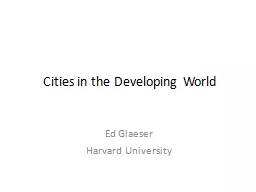

Ed Glaeser Harvard University I regard the growth of cities as an evil thing unfortunate for mankind and the world Country Largest City Population Percent Urbanized Percent in Million Agglomerationgt ID: 273590
Download Presentation The PPT/PDF document "Cities in the Developing World" is the property of its rightful owner. Permission is granted to download and print the materials on this web site for personal, non-commercial use only, and to display it on your personal computer provided you do not modify the materials and that you retain all copyright notices contained in the materials. By downloading content from our website, you accept the terms of this agreement.
Slide1
Cities in the Developing World
Ed
Glaeser
Harvard UniversitySlide2
“I regard the growth of cities as an evil thing, unfortunate for mankind and the world. ”Slide3Slide4Slide5
Country
Largest City
(Population)
Percent Urbanized
Percent
in Million+ Agglomeration>
GDP P.C. 2010$(PPP Adjusted)Congo(Dem. Rep)Kinshasa(9 Million).34.17210(330)ZimbabweHarare(1.6-2.8 Million).38.12625(missing)MaliBamako(1.8 million).34.13650(1100)HaitiPort-au-Prince(1 – 2.4 Million).52.21700(1000)PakistanKarachi(23.5 Million).36.191100(2400)SenegalDakar(1-2.5 Million).42.241100(1700)
Poor (under $1200 p.c.), Populous Countries that are one-third urban, Slide6Slide7Slide8
The Strength of Urban Poverty?Slide9Slide10
Happiness across the United StatesSlide11
The Urban Triad
The Physical City by
rulto
Government battling the Demons of Density
The Economic Magic of Human Interaction by
חדוה שנדרוביץ
Slide12Slide13Slide14
Do Cities Increase Productivity?
Random Shocks to Location for Individuals
Roots in the individual fixed effect literature
Similarities with Randomizing Across Peers
Doesn’t deal with omitted place level factors
Random Shocks to the Density Level
If long term, these must be orthogonal to current productivity (Combes et al. 2010)Or taking advantage of high frequency variation (Greenstone, Hornbeck, Moretti)An alternative is to estimate the flow of ideas within a network (Duflo and Saez, 2003)Real estate prices as a sign of WTP for proximitySlide15
Combes
,
Duranton
,
Gobillon
and RouxSlide16
Human Capital and Urban SuccessSlide17Slide18Slide19Slide20
Relocation of Departments in the 50s
(joint with Lu Ming)Slide21
Joint with
Yueran
MaSlide22
Chinitz: Contrasts in Agglomeration: New York and PittsburghSlide23Slide24
Copper Mines and EntrepreneurshipSlide25
South
Boston
Waterfront
Innovation District
Logan
Airport
DowntownSlide26
Policy Related Questions
Explicit Spatial Policies
Should be city sizes be limited? Optimal city size?
Investment in Infrastructure
Roads and railroads but
endogeneity
is difficultEducation and human capital spilloversOld questions remain (primary vs. secondary)New crop of great experimental work. Regulation, credit market, labor market matching questions all relate to cities.Encouraging Entrepreneurship in CitiesOne Stop Permitting Slide27Slide28
Government Effectiveness and UrbanizationSlide29
GDP Under $1500, Pop>2 MillionSlide30
Waste and Fraud in Infrastructure:The Institutional ChallengeSlide31Slide32
Author:
BranilleSlide33
Engineering vs. EconomicsSlide34
Transportation and Congestion
The traditional literature used engineering estimates and engaged in cost-benefit analysis
Fundamental conclusion is “bus good; train bad”
A newer literature uses cross-metropolitan area estimates to determine the impact of new infrastructure projects.
Baum-Snow (military map) on suburbanization
Duranton
-Turner on the fundamental law of highway traffic and impact of roads on MSA gdpA parallel literature in developing economiesBanerjee, Duflo and Qian (2012). Requires the exogenous location of infrastructureSlide35
Anarchy vs. Authority
Photo by
SuSanA
Secretariat
RayKelly
by David
ShankboneSlide36Slide37
The Brazil Model: The Dentist and the Supermarket
Supermarket by
WonderlaneSlide38
NIMBYism vs. Monumentalism
Astana by
ChelseaFunNumberOne
-Slide39
Housing Markets, Property Rights and Regulation
Successful cities have high land costs which translates into high costs of living.
Housing costs are mediated by levels of regulation
Impact of property ownership on outcomes (
DeSoto
, Erica Field) through self-protection or ability to finance new investment.
Impact of structure on outcomes through health– the bore holes problem and the Tenements law. The Western pattern was that property rights were developed first (12th-18th centuries) but regulation followed. Not so in the developing world. Large unregulated communities with dimly defined property rights. Slide40Slide41Slide42Slide43
Fact 1 (obvious one
):
Price increases are spectacular
Source: Wharton/NUS/Tsinghua
Chinese Residential Land Price Indexes Slide44
Fact 2 (relatively obvious):
Prices are not cheap compared to income
A conservative estimate: In many of the 35 major cities by 2005, average annual disposable income is worth around 2-3 square meters (20-30 square feet) of housing
. It is even worse now. Slide45
Fact 3 (not so obvious):
Prices are way higher than physical costs of constructionSlide46
Fact
4:
Real estate is the largest component
of household wealth in China
Not an entirely fair comparison as real estate asset is perhaps the largest component of household wealth for US households outside of the highest income brackets. But in China, even rich households have a lot of their assets in real estate as well.Slide47
Fact 5: Even when things turn sour,
prices don’t adjust immediately
Some moderate correlation between area not sold and price declines as of 2012, but literally no correlation before 2011. Slide48
Image by
QuarterCircleSSlide49Slide50Slide51
Image by
Ramy
Raoof
The Boston Hypothesis